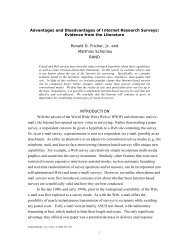Boosted Regression (Boosting): An introductory tutorial and a Stata ...
Boosted Regression (Boosting): An introductory tutorial and a Stata ...
Boosted Regression (Boosting): An introductory tutorial and a Stata ...
Create successful ePaper yourself
Turn your PDF publications into a flip-book with our unique Google optimized e-Paper software.
interaction=2, then each tree has 3 terminal nodes, <strong>and</strong> so forth. By defaultinteraction=5.maxiter(int) specifies the maximal number of trees to be fitted. The actual number used,bestiter, can be obtained from the output as e(bestiter). When bestiter is too close tomaxiter the maximum likelihood iteration may be larger than maxiter. In that case it isuseful to rerun the model with a larger value for maxiter. When trainfraction=1.0 allmaxiter observations are used for prediction (bestiter is missing because it is computedon a test data set).shrink(#) specifies the shrinkage factor. shrink=1 corresponds to no shrinkage. As ageneral rule of thumb, reducing the value for shrink requires an increase in the value ofmaxiter to achieve a comparable cross validation R2. By default shrink= 0.01.bag(real) Specifies the fraction of training observations that is used to fit an individualtree. bag=0.5 means that half the observations are used for building each tree. To use allobservations specify bag=1.0.By default bag=0.5.seed(int) seed specifies the r<strong>and</strong>om number seed to generate the same sequence ofr<strong>and</strong>om numbers. R<strong>and</strong>om numbers are only used for bagging. Bagging uses r<strong>and</strong>omnumbers to select a r<strong>and</strong>om subset of the observations for each iteration. By default(seed=0). The boost seed option is unrelated to <strong>Stata</strong>'s set seed comm<strong>and</strong>.4 <strong>Boosting</strong><strong>Boosting</strong> was invented by computational learning theorists <strong>and</strong> later reinterpreted<strong>and</strong> generalized by statisticians <strong>and</strong> machine learning researchers. Computer scientiststend to think of boosting as an “ensemble” method (a weighted average of predictions ofindividual classifiers), whereas statisticians tend to think of boosting as a sequentialregression method. To underst<strong>and</strong> why statisticians <strong>and</strong> computer scientists think aboutthe essentially same algorithms in different ways, both approaches are discussed. Section4.1 discusses an early boosting algorithm from computer science. Section 4.2 describesregression trees, the most commonly used base learner in boosting. Section 4.3 describesFriedman’s gradient boosting algorithm, which is the algorithm I have implemented for5



